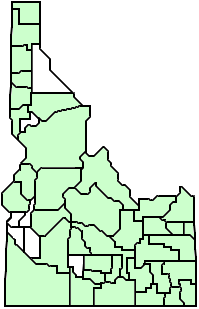Source: Idaho's Noxious Weeds by Robert H. Callihan & Timothy W. Miller
BACKGROUND
Leafy spurge (Euphorbia esula) was brought to the U.S. from Eurasia about 1897. A milky latex exists in all parts of the plant that can produce blisters and dermatitis in humans, cattle, and horses and may cause permanent blindness if rubbed into the eye. Protection is need when handling leafy spurge. It spreads both by seed and creeping roots and grows in many environmental conditions.
DESCRIPTION
Leafy spurge is a perennialPlant that lives for more than 2 growing seasons weed with roots often exceeding 20 feet in depth. Plants develop from pinkish root buds from any depth. Leaves are narrow and up to 4 inches long. Stems grow up to 3 feet in height, and in midsummer are tipped by several pairs of showy, yellowish-green, heart-shaped bractsLeaflike structure at the base of flowers or leaves (each up to 1/3 inch across), which enclose a small flower. Stems and leaves exude a milky latex when broken. Ripe seed capsules rupture when touched, throwing seeds as far as 15 feet.

DISTRIBUTION
Found throughout the West.
CONTROL
Biological control agents (several stem/root boring beetles, a shoot tip gall midge, a stem boring moth, and 3 root/defoliating flea beetles) have been inconsistent in Idaho. Sheep and goats have been used to check the rate of spread of leafy spurge. Herbicides are available for control.


